1.0 BODY CULTURE
Is yoga a sport?
A principle asked that provoking question at a strategy meeting at one of the main sport equipment manufacturers in the early 2000s. This might sound ordinary at first sight, however it highlights a phenomenon that re-evaluates the meaning of sports and physical exercises.
Sport, by its classical definition, refers to competitive sports that focus on extraordinary performances; the sportsman’s challenge is to be faster, higher or stronger in the given field. To achieve that, professional mega organizations have emerged in the past to provide these people with better and better training conditions. Nevertheless, sport (=competitive sports) simultaneously has distanced itself from the majority of people, since not everyone dreams of or has the ability to play in groups or push the limit of their bodies.
The significance of the ‘Is yoga a sport?’ question was that a sport equipment manufacturer realized that they can reach less people with equipments designed for professionals, because an increasing number of people had been choosing alternative ways to practice (e.g. jogging, yoga, pilates, aerobic, fitness) and their dress accessories. The company wanted to keep its success rates; a paradigm shift was necessary.
Body culture, that studies physical activities that are somehow related to city people’s lifestyle, evolved in the 1900s, but it was in the 1980s that Danish universities, with an extensive European research network and with other related sciences such as medical and social sciences or fashion, raised it onto a professional level. Body culture refers to a wide spectrum of daily physical activities and studies their physiological effects. These activities include the basic physical activities (standing, slow walking, lifting lightweight objects), health improving physical activities (fast walking, running, jump rope workout, dance, tennis, football), housework related physical activities (sweeping, mopping, window cleaning), work related physical activities (walking, weightlifting, pulling–pushing objects, shoveling) and free time related, recreational physical activities (workout, sport, hobbies).
Researches provide experts with a more exact idea about city people’s lifestyle and these results can enrich their research fields as well. This paradigm shift has given new impulses to sport sciences (recreation), tech developments (mobile apps for workouts) or even to fashion among others (bicycle as fashion).
Architecture and urban design, despite that these are rather slowly moving entities, are capable and liable for reflecting on people’s lifestyle changes (as we can see some early examples in Scandinavian countries). Architects, urban and landscape designers, urban thinkers and politicians have the chance to implement ideas in new urban projects that help and improve city peoples’ recreation, and also inspire for more physical activities in the city regarding age, gender and capabilities.
We believe that the extension of Millenáris Park should integrate all these knowledge and be the very first planned body culture park in Budapest.
2.0 INDIVIDUAL AND SOCIAL BENEFITS
The benefits of physical exercise on health and well-being are widely known.
People choose bicycle as a way of transportation over cars or public transport, because they can freely move around in the city, experience more of its atmosphere and have less polluting effect on the environment. Jogging, longer walks or time spent with children and pets have positive effects on health and well-being, recharge one’s batteries that improves working efficiency and capacity.
People’s physical activity has significantly decreased in developed countries and sedentary lifestyle has become general; this inactive life is especially typical in Hungary. 93% of the Hungarian population exercise less than 2x40 minutes a week. Sedentary lifestyle nevertheless intensifies the likeliness of developing coronary artery diseases, type 2 diabetes, cancer, heart attack, mental disorders or depression. According to the Statistical Yearbook (2008) by the Hungarian National Heart Foundation, death caused by coronary artery disease is 300% higher in Hungary than in Western European countries. The treatment of this very disease costs 3,852 HUF for each citizens, and, regarding the additional losses (early death, a drop in productivity caused by the time spent in illness, other expenses that acquaintances must bear), totals in 23,929 HUF per citizens, that takes up about 240 billion HUF at a national level.
According to the World Health Organization’s 2010 recommendations, the risk of the above mentioned diseases can be significantly decreased with regular physical exercises. A weekly 150-minute moderate exercise (intense walking) or 75-minute active exercise (running) can increase life expectancy by 3-4 years.
From the architectural and urban design point of view we recommend the design of urban spaces that helps promoting the benefits of an active lifestyle. This project proposes a green urban park that provides capacity for various types of physical exercises. People in this green urban body culture park don’t eventually realize they work out: e.g. walking in the undulating landscape doesn’t mean more than just walking, but is actually a intensive exercise that burns 223 kcal/30min.
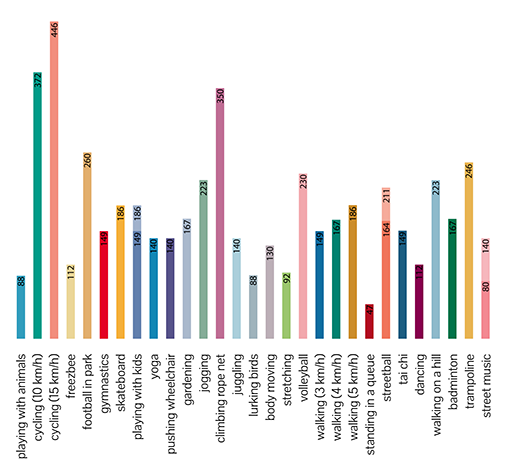
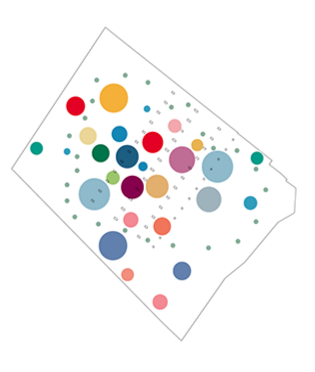
Fig.1. Calories burnt in 30 minutes (70 kg man, kcal) and these activities arranged on the site
3.0 PRINCIPLES
3.1 GREEN AREAS
Budapest, compared to European average values, lacks green urban areas. While the European average is 21.00 m2 per capita, Budapest (the city) has 14.40 m2 per capita. Some central districts have lower than 1.00 m2 per capita, the value in the 2nd district is 4.20 m2 per capita (source: Védegylet 2006, Budapest Portál), which is far lower than the WHO 9.00 m2 per capita recommendation that guarantees a balanced urban lifestyle.
II.district
Budapest
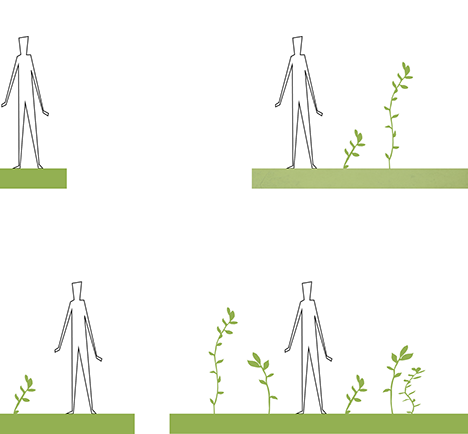
4.20 m2/person
14.40 m2/person
21.00 m2/person
9.00 m2/person
WHO minimum
European average
Fig.2. Green Areas In Urban Environment per capita (2006)
source: Védegylet 2006
Studies show that in the present situation while Margitsziget and Városliget are two, functionally overcrowded parks in Budapest, other green areas in the inner green belt are either abandoned or functionally and programmatically undeveloped areas. This project also proposes a long-term green decentralization strategy in central Budapest to relieve the unbalanced functional organization among the city parks.
According to the facts above, we believe that the extension area of Millenáris Park must accommodate an intensive 4-level greenery, which, joined together with Millenáris 1, will be a new, big-scale green urban park in the city.
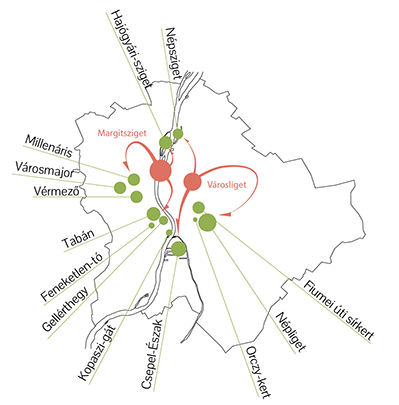
Fig.3. Decentralizing Budapest green areas
3.2 MILLENÁRIS 1 AND MILLENÁRIS 2 (SZÉLLKAPU)
It is important that beyond its spatial continuity, the two areas should also join on conceptual level and in spatial-functional organization. Millenáris 1 serves for intellectual recreation with its cultural institutions, Millenáris 2 would serve for body culture and more active physical recreation. Linking the intellectual with the physical, this expanded green area would become a fully comprehensive recreational urban space. This unique duality bears such a significant touristic potential that could relieve the crowdedness of Margitsziget’s recreational areas.
The concept (and its success) of Millenáris 1 was the creation of its unique landscape: instead of designing flat park surfaces, a flow of diverse, vertically separated micro spaces with different themes and experiences joined together. This project follows the principles of this landscape design. Firstly, the undulating topography organically connects a range of diverse functions and experiences, secondly provide a spatial base for body culture purposes.
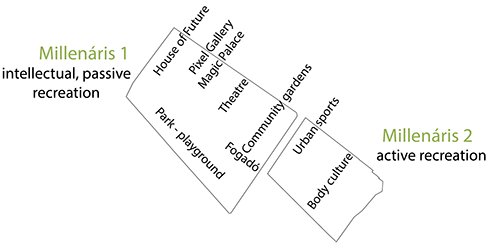
Fig.4. Spatial and functional continuity between Millenáris 1 and 2
3.3 A FOUND OBJECT
Another important connecting element between the two parks is the (once listed) Ganz factory building. The former industrial park is Central Buda’s unique architectural heritage and also a complex of several factory buildings of high historical significance. It’s worth considering the historical value of each building, but we believe that it is the complex as a whole structural entity that is worth preserving.
In order to integrate a diverse range of body culture activities into the new landscape, some vertical elements and covered horizontal areas are needed. This project, instead of creating new pavilions around the area, proposes the structural RC pillars and beams of the old factory building to be kept in order to provide verticality in the area. This structure embedded in the undulating landscape organizes the tiny equipments and functions, and also keeps the continuity of the 2 areas’ industrial character.
We consider the pillar structure as a “found object”, which means that all surfaces and other physical qualities are kept as they are present, just an external surface treatment layer is applied. The new elements needed for body culture related installations and shading (suspended wire sheet, swing, streetball plank, waterfall, growing plants) are spatially related to this found object: lean on it, being suspended, run over it.
3.4 PARKING
The project does not calculate with underground parking facility nor with big-scale surface parking areas because of the following factors:
1. Traffic needs to be reduced in the centre of Budapest. Both the Budapest Integrated City Development Strategy and the Budapest 2030 Urban Development Plan provides perspectives on the issue. The reconstruction plan of Széll Kálmán Square also shares the same principles. The necessary P+R parking facilities must be located at Budagyöngye or further out. There are several underground parking lots in the area (Mammut Mall, Millenáris 1) with sufficient capacity, and a new one is going to be functioning at Széll Kálmán Square as well.
2. In order to realize the significant green and recreational goals that we have proposed, a plantation of an intensive 3-4 level greenery is necessary (1. short and mid-high grasses, 2. shrubs, 3. trees, 4. running green on the preserved RC pillar structure). This is only possible if no underground structure cuts the soil for roots.
3. The concept of body culture is in contrast with the increase of the neighbourhood traffic. This park serves firstly the neighbourhood population, secondly provides a recreational green area for the whole city.
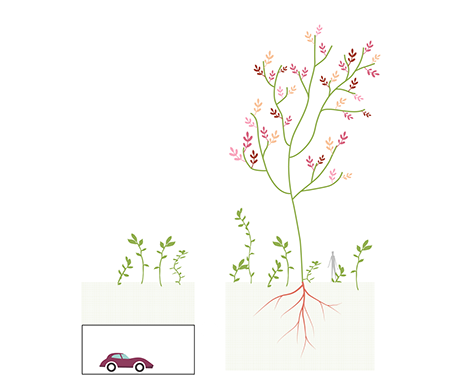
Fig.5. Parking and green relations